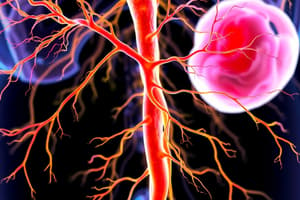Podcast
Questions and Answers
Which pathway describes the innervation of visceral organs?
Which pathway describes the innervation of visceral organs?
- Axons enter the sympathetic chain and either ascend or descend to synapse in a paravertebral ganglion and exit on the spinal nerve
- Axons enter the sympathetic chain and either ascend or descend to pass through a paravertebral ganglion at another level and exit on a splanchnic nerve to synapse in a prevertebral ganglion (correct)
- Axons enter the sympathetic chain, synapse in the paravertebral ganglion, and exit on the spinal nerve at the same level
- Axons enter the sympathetic chain, the signal passes through the paravertebral ganglia at the same level, and then exits on a splanchnic nerve to synapse in a prevertebral ganglion
Which pathway describes the innervation of blood vessels and glands in the skin?
Which pathway describes the innervation of blood vessels and glands in the skin?
- Axons enter the sympathetic chain, synapse in the paravertebral ganglion, and exit on the spinal nerve at the same level (correct)
- Axons enter the sympathetic chain and either ascend or descend to synapse in a paravertebral ganglion and exit on the spinal nerve
- Axons enter the sympathetic chain and the signal passes through the paravertebral ganglia at the same level and exits on a splanchnic nerve to synapse in a prevertebral ganglion
- Axons enter the sympathetic chain and either ascend or descend to pass through a paravertebral ganglion at another level and exit on a splanchnic nerve to synapse in a prevertebral ganglion
Which statement accurately describes the innervation of blood vessels and glands in the skin?
Which statement accurately describes the innervation of blood vessels and glands in the skin?
- Axons can enter the sympathetic chain, synapse in the paravertebral ganglion, and exit on the spinal nerve at the same level (correct)
- Axons can enter the sympathetic chain and either ascend or descend to pass through a paravertebral ganglion at another level and exit on a splanchnic nerve to synapse in a prevertebral ganglion
- Axons can enter the sympathetic chain and either ascend or descend to synapse in a paravertebral ganglion and exit on the spinal nerve
- Axons can enter the sympathetic chain and the signal can pass through the paravertebral ganglia at the same level and then exit on a splanchnic nerve to synapse in a prevertebral ganglion
Flashcards are hidden until you start studying
Study Notes
Innervation of Visceral Organs and Skin
- The innervation of visceral organs occurs through the visceral motor pathway.
- The innervation of blood vessels and glands in the skin occurs through the somatic motor pathway.
- The somatic motor pathway is responsible for the innervation of blood vessels and glands in the skin, controlling functions such as vasodilation and sweat gland secretion.
Studying That Suits You
Use AI to generate personalized quizzes and flashcards to suit your learning preferences.




